
Wildlife Conservation
Preserving the Wild for Future Generations!

Wildlife Conservation
Preserving the Wild for Future Generations!
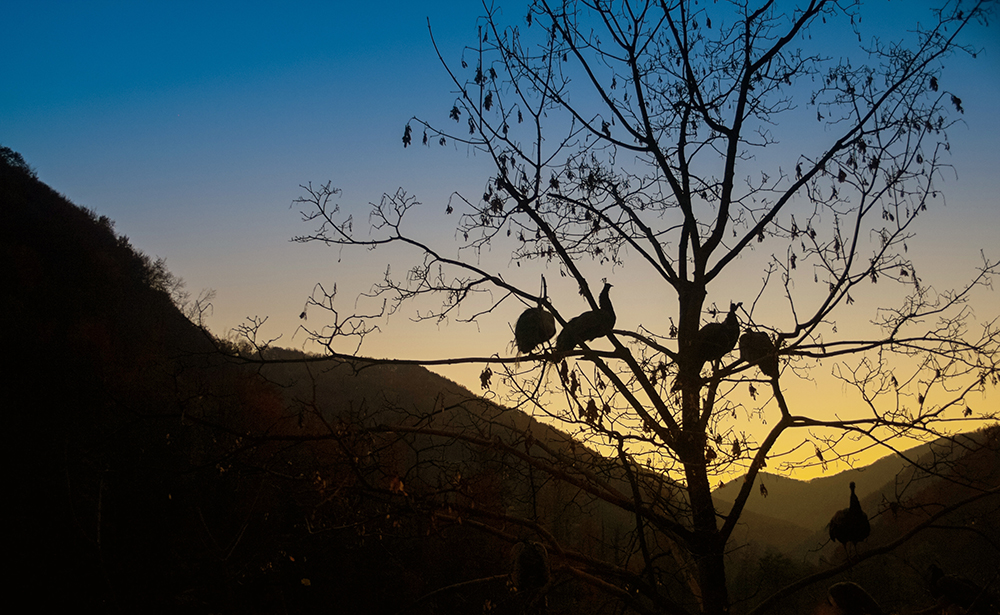 It is our responsibility to promote the welfare of all animals and preserve human interaction with the natural world. It is our responsibility to promote the welfare of all animals and preserve human interaction with the natural world.
|
A child visits the zoo, spies his first elephant and exclaims in delight. A hunter considers a day in the woods a success if he even sees his quarry but doesn’t get a clear shot and goes home empty-handed. A grandfather and his grandson sit quietly by a stream, fishing poles in hand, waiting for the big strike. A farmer tries to balance his respect for a natural predator with his need to protect his livestock. A suburban family participates in an annual backyard bird count.
Zoos, hunting, fishing, birdwatching, and predator conservation all fall within man’s mission and responsibility to promote the welfare of all animals and preserve human interaction with our natural world. We accomplish these goals through
However, critical as it is to understand the complexities of wildlife conservation and make informed opinions and decisions about interactions with non-domestic animals, many Americans either ignore the connections until the bear is on the back porch or support views and policies based on simplistic answers to difficult questions. To help in this quest to nurture and protect man’s place in nature, we present this overview of our positions and a historical perspective of the environmental movement in the US.
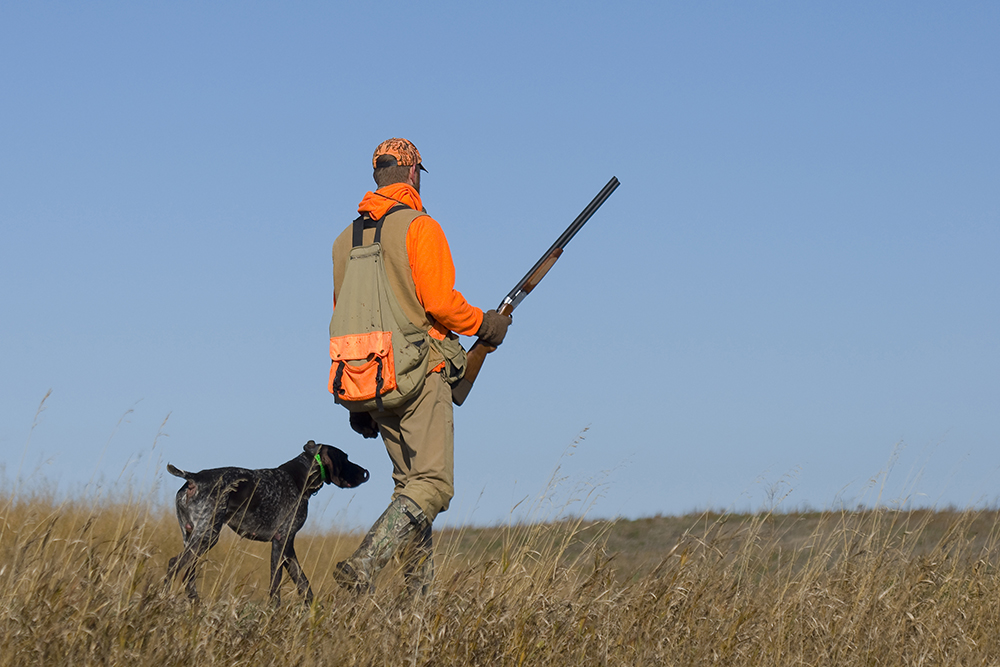 Hunting and fishing continue to provide a link to the earth and the cycle of life for many Americans. Hunting and fishing continue to provide a link to the earth and the cycle of life for many Americans.
|
Once necessary for survival throughout the world, hunting and fishing continue to provide a link to the earth and the cycle of life for many Americans. Today, these pastimes provide opportunities for families to enjoy the outdoors together, to learn about wildlife and the environment, and to reconnect with the past. Hunting and fishing are also game management tools, providing both dollars and expertise for saving species and habitats and culling excess populations of animals that destroy wildlife habitat and human property, serve as reservoirs for zoonotic diseases, and present a danger to people and pets.
Trappers were among the first inland explorers of the New World, and an active and lucrative trade in furs played a significant role in opening the US and Canadian frontiers. Today, areas of urban, suburban, and rural development leave little usable wild space for indigenous animals and allow some species to overrun populated areas or cause serious damage to farms, parks, estuaries, and other open spaces. Trapping helps alleviate conflicts caused by overpopulation of species that cause damage and is a valuable management tool for relocating threatened populations of endangered species and transferring species from areas of plenty to other suitable habitats.
Americans have unique opportunities to influence and embrace scientific wildlife management that integrates species conservation while recognizing and supporting human interaction with the natural environment. We not only have federal and state fish and game agencies to write and enforce reasonable regulations, we have private organizations of ethical hunters, trappers, and anglers that work with the agencies and each other on projects large and small to preserve and recover wetlands, prairies and other habitats, and countless numbers of small nature groups and organizations to do local hands-on conservation work. We also have a large contingent of corporations and other businesses that help with dollars and land donations, and farmers, loggers, ranchers, city planners, and others who incorporate concern for wildlife into their land use plans.
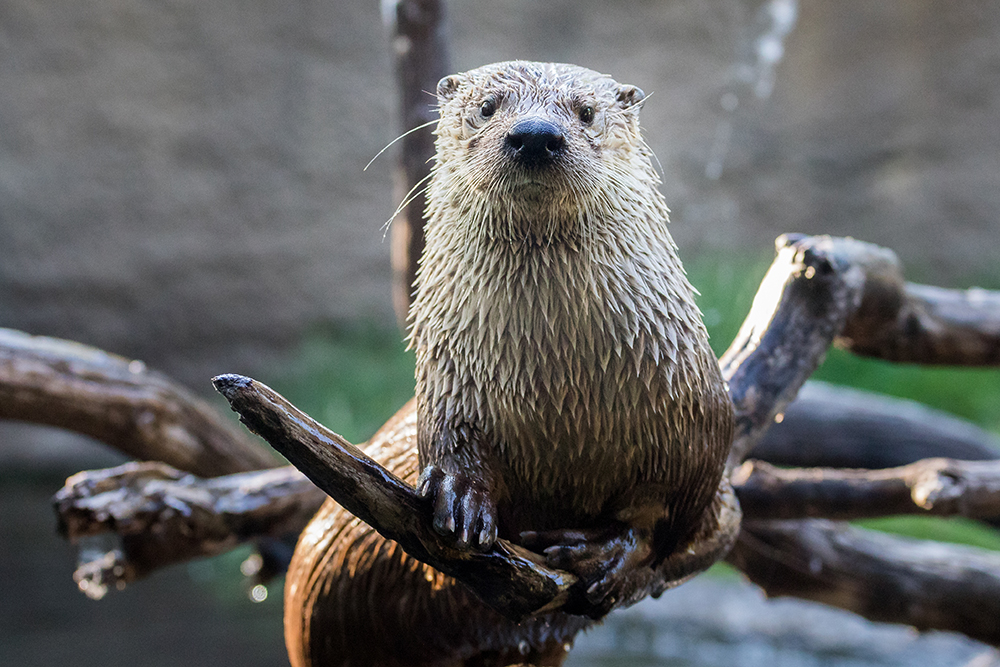 Conservation efforts to restore animals, such as river otters to their former habitats have been highly successful. Conservation efforts to restore animals, such as river otters to their former habitats have been highly successful.
|
Among our most valuable assets is the incorporation of public-private partnerships such as the federal “safe harbor” and “no surprises” sections of the Endangered Species Act; the joint projects of hunting and trapping groups and state fish and wildlife agencies; and the billions of dollars devoted to conservation by individual hunters and anglers through taxes on their guns, fishing gear, and other equipment.
Exotic species in zoo habitats and aquaria give millions of families chances to see and learn about magnificent animals they would never see in their natural habitats. These displays also provide scientists with opportunities to study the biology and behavior of these species and develop reproductive strategies to help save those that are endangered and open opportunities for donations to aid in conservation efforts of endangered animals throughout the world.
 Zoos and Aquaria give millions of families chances to see and learn about magnificent animals they would never see in their natural habitats. Zoos and Aquaria give millions of families chances to see and learn about magnificent animals they would never see in their natural habitats.
|
Visit NAIA’s policies and positions for more information. Now onward to our historical perspective of the environmental movement in the US.
"Without natural resources life itself is impossible. From birth to death, natural resources, transformed for human use, feed, clothe, shelter, and transport us. Upon them we depend for every material necessity, comfort, convenience, and protection in our lives. Without abundant resources prosperity is out of reach." - Gifford Pinchot
The Merriam-Webster dictionary defines conservation as “the careful preservation or protection of something,” and especially “the planned management of a natural resource to prevent exploitation, destruction or neglect.”
The relationship between humans and the soil, water, plants and animals we rely on for sustenance has changed with the passage of time and the advance of scientific knowledge about our natural environment.
Humans have used and affected fish and wildlife since the dawn of our species. For many millennia, Homo sapiens altered the land and wildlife habitat to meet subsistence needs, but it was not until the advent of agriculture that we began to have outsized impacts. Direct conversion of land for crops, a desire to protect livestock and families from predators, and in some cases, to market animal products all took a great toll on native wildlife. The industrial age further increased human demands on the landscape to the detriment of many fish and wildlife populations.
But even before the peak of the industrial age, we had visionaries who saw the land and its creatures as assets, as things of beauty, and above all, as marvels to save. These defenders of our natural world provided a foundation for the broad and deep respect for wildlife and wild places that is woven into US society today.
Unfortunately, some organizations use that concern for wildlife to raise money and put their own policies in place. The groups cherry-pick environmental science, capitalize on tragedies, mix in some emotion, and use the courts, legislative initiatives, and susceptible lawmakers to restrict man’s contact with and use of animals.
Other modern organizations and agencies carry on in the spirit first articulated by our early environmentalists. Hunters, anglers, and their associations have given billions of dollars directly to wildlife projects; zoos and aquaria are in the forefront of research to save species and teach the public about animals; and state agencies identify problems and coordinate projects to preserve habitat and manage populations.
How did we get from there to here? First some history, then a look at who is doing what to and for wildlife.
The wilderness that greeted European settlers to the New World was an obstacle to be both feared and conquered. Explorers wrote of lands teeming with fish and land creatures, but driven by the need for food, fiber, shelter, and safety, settlers pushed back the forests, killed game, and plowed the prairies to carve out their homesteads, villages, forts, and towns.
Beyond creating these basic physical necessities, they had to start from scratch to build spiritual and legal frameworks for their new communities, activities that left little time or energy to consider the impact on the land they tamed or the animals they displaced or killed.
Change came slowly. In 1803, following the Louisiana Purchase, President Thomas Jefferson commissioned an army expedition to find a passage across the newly acquired western territory, establish relationships with Native American tribes, and study the plant and animal life and geography of the area they traversed. Led by Captain Meriwether Lewis and Second Lieutenant William Clark, the journey took nearly two and a half years from May 1804-September 1806. The Lewis and Clark expedition documented more than 200 new plant and animal species and described geographic features in detailed journals of their trek.
The 19th Century was a time of turmoil as industrialization, the opening of the West, and the Civil War took center stage in the country’s development. Population skyrocketed with the arrival of millions of immigrants from Europe and Asia. In just fifty years (1840-1900) the population of America’s fifty largest cities nearly doubled from about 40 million to 76 million. The frenzy to settle the West, expand economic development, and accommodate the burgeoning population inevitably corresponded with a period of resource extraction and environmental degradation.
By the early 1900s, the tide began to turn towards conservation. With the encouragement of environmental activist John Muir and others, President Theodore Roosevelt had doubled the number of America’s national parks from five to 10, and professional forester Gifford Pinchot was teaching colleagues how to harvest timber and simultaneously replace timber stock to ensure the sustainability of the nation’s woodlands. Pinchot’s approach to forestry is the model on which forestry practice has been based ever since. Muir and Pinchot were friends, but they parted ways when their philosophies diverged; Muir took a preservationist view of the environment, and Pinchot a utilitarian one – a divide that still characterizes todays environmental movement.
Senator John Lacey, who wrote America’s first wildlife conservation statute, the Lacey Act, and shepherded it through Congress, characterized overconsumption this way: “[f]or more than three hundred years destruction was called 'improvement' and it has only in recent years come to the attention of the people generally that the American people were like spendthrift heirs wasting their inheritance.”
Signed into law in 1900, the Lacey Act protects plants and animals by creating penalties for those who violate hunting rules and regulations, authorizes the Secretary of Interior to help restore game and birds that have become rare, and regulates the introduction of animals and birds to new habitats. The Act has been amended several times and now governs the possession of and commerce in animals and animal parts taken in violation of federal or state law or the International Convention on Trade in Endangered Species.
Lewis & Clark described “immence [sic]” bison herds, one of which appeared to fill a twelve-mile-long valley. By the early 1900s, however, sharpshooters hired by the railroads had decimated the herds that once roamed the prairies by the millions, and the species was in danger of extinction. The New Your Zoological Society spear-headed a conservation effort and restored the herd to nearly a half-million individuals.
 There are now a half-million bison, but they were nearly decimated in the early 1900s! There are now a half-million bison, but they were nearly decimated in the early 1900s!
|
Leopold’s Land Ethic
It was Wisconsin scientist and naturalist Aldo Leopold who first applied Roosevelt’s and Pinchot’s management principles to wildlife. In 1933, Leopold published Game Management, his landmark book describing how to conserve, sustain and restore wildlife populations through scientific ecological management. His based his theory on what he described as the “land ethic.” Here’s how Leopold articulated his vision:
“The land ethic simply enlarges the boundaries of the community to include soils, waters, plants, and animals, or collectively: the land.”
"A thing is right when it tends to preserve the integrity, stability, and beauty of the biotic community. It is wrong when it tends otherwise."
Today, all fifty states in the US and most countries in the world have established science-based wildlife conservation programs to prevent existing species from becoming endangered, to balance human use with conservation principles, and to strive for ecological stability.
Wildlife management practices and challenges vary from state to state and among nations, but there are some basic principles that underlie virtually every effort. The Association of Fish and Wildlife Agencies is the trade organization for state, provincial and national fish and wildlife conservation agencies. Its members follow a philosophy collectively known as the North American Model of Wildlife Conservation to guide them as they manage fish and wildlife resources for the people. Known as the Seven Sisters, the key elements are:
1 – Wildlife is held in the public trust
In North American, natural resources and wildlife on public lands are managed by government agencies to ensure that current and future generations always have wildlife and wild places to enjoy.
2 – Prohibition on commerce of dead wildlife
Commercial hunting and the sale of wildlife is prohibited to ensure the sustainability of wildlife populations.
3 – Democratic rule of law
Hunting and fishing laws are created through the public process where everyone has the opportunity and responsibility to develop systems of wildlife conservation and use.
4 – Hunting opportunity for all
Every citizen has an opportunity, under the law, to hunt and fish in the United States and Canada.
5 – Non-frivolous use
In North America, individuals may legally kill certain wild animals under strict guidelines for food and fur, self-defense and property protection. Laws restrict against the casual killing of wildlife merely for antlers, horns or feathers.
6 – International resources
Wildlife and fish migrate freely across boundaries between states, provinces and countries. Working together, the United States and Canada jointly coordinate wildlife and habitat management strategies. The Migratory Bird Treaty Act of 1918 demonstrates this cooperation between countries to protect wildlife. The Act made it illegal to capture or kill migratory birds, except as allowed by specific hunting regulations.
7 – Scientific management
Sound science is essential to managing and sustaining North America’s wildlife and habitats. For example, researchers put radio collars on elk to track the animals’ movements to determine where elk give birth and how they react to motor vehicles on forest roads.
Some people believe that human beings should leave animals alone to manage themselves. However, that is not a practical alternative. Humans and non-humans share this planet, and we can’t avoid affecting each other. Humans move into animal habitats, and animals encroach on developed areas. Animals also affect the environment in the way they feed upon plants and other animals. Our ecosystem—the “web of life”—is just too complex to believe that there can be a bright-line separation between humans and animals. And who would want that anyway? Interacting with animals and nature is one of life’s greatest pleasures.
The solution is responsible management. In keeping with the North American Model, wildlife professionals have learned how to manage wildlife and habitats to ensure ecological balance. Based on scientific study and analysis, they determine which species are abundant, which might be endangered or threatened, and how many healthy animals the environment can support.
Invasive species are a huge threat to our native species and ecosystems. What creative solutions are people using to control them?
Water Buffalo?! Eat Them! Bring in the Beetles!
The maximum number of healthy animals that can live in a given area without environmental degradation is known as the “carrying capacity.” When populations of certain species—deer, for example—increase beyond the ability of the environment to support them, management tools such as hunting come into play. Natural resource and wildlife management officials establish bag limits and other regulations to ensure that the number of deer is always sustainable for the area. When there are too many deer, they may raise bag limits; when there are too few deer, they reduce bag limits.
Growing Pains
Failure to properly manage wildlife often has serious consequences for people, animals and the environment. In some cases, importations of non-native animals such as the nutria, a large rodent raised for its fur, and the mute swan, a ravenous feeder on water plants, have resulted in over-population of a species without natural enemies and a resulting degradation of habitat and confrontations with people. In others, political and social considerations have interfered with scientific management of native species such as white-tailed deer and black bears.
The people of Louisiana learned that lesson firsthand, courtesy of the nutria, a small semi-aquatic rodent that feeds on wetland plants and nearby farm crops. Fur farmers imported the species from its native Argentina and other areas where it had been introduced, but the market for pelts became glutted and many of their farms went under. Nutria escaped or were released into the marshes along the Gulf Coast in the 1930s.
Nutria breed twice a year; within a few years, populations soared to more than 20 million, the rodents were consuming plants, rice and sugarcane fields, denuding natural levees, increasing the pace of soil erosion and driving other species out of the bayous.
To solve the problem, Louisiana began promoting the value of nutria fur as a natural, renewable resource. The state offered financial incentives for trapping nutria, an approach that worked exactly as intended. Reports of nutria damage declined substantially as trappers began harvesting nutria under state rules. To this day, Louisiana conducts an aggressive nutria control program to maintain a balance between these voracious creatures and their marshy habitat.
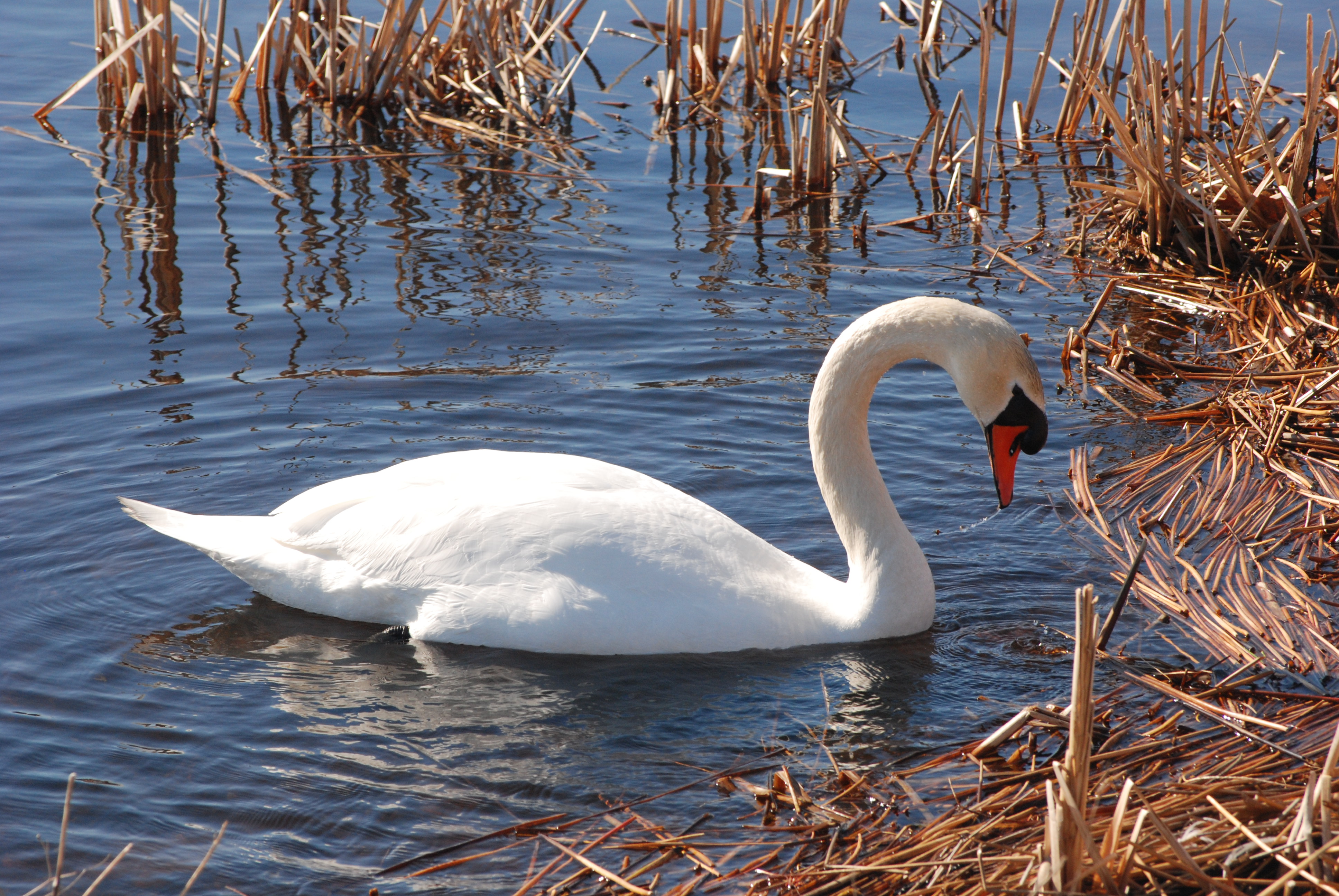 Mute swans are wreaking havoc on lakes, marshes, and estuaries. Photo by Jon Woolf. Mute swans are wreaking havoc on lakes, marshes, and estuaries. Photo by Jon Woolf.
|
The beautiful mute swans were released on eastern estates in the late 1800s for their aesthetic value, and today are wreaking havoc on lakes, marshes, and estuaries from the East Coast to Washington and Oregon in the west. Aggressive to people, mute swans destroy submerged aquatic vegetation, displace native wildlife species, degrade water quality, and are potential hazards to aviation Wildlife agencies in the affected areas are working on control programs, but many have so far been unsuccessful in substantially reducing the numbers of birds, in part because of activist campaigns against trapping and killing them.
For another example of the need for wildlife management, just look skyward. On January 15, 2009, a US Airways flight taking off from LaGuardia Airport in New York City crash-landed in the Hudson River after several Canada geese flew into the jet’s engines. The geese damaged both engines, causing them to fail. Only the phenomenal skill of the plane’s pilot and crew averted a catastrophic disaster.
One media report indicated that bird and other wildlife strikes to aircraft result in more than $600 million in damage a year. Five jet airliners have had major accidents involving bird strikes since 1975. In one case, about three dozen people died. A total of more than 200 people worldwide have died in such accidents since 1988.
To reduce the risk of bird strikes, wildlife management professionals have come up with several steps, including:
On some occasions, agencies use lethal means to prevent geese and other wildlife from jeopardizing aviation safety. The use of lethal means requires state and federal permits since most migratory birds are protected under international treaties.
Animal Rights Campaigns vs Scientific Management
Animal rights extremists who oppose human “interference” in nature often challenge wildlife management experts, especially if management programs involve killing. In some states, animal rights organizations promote initiatives and referenda to dictate how wildlife agencies manage the natural resources under their jurisdiction. These measures diminish or remove the role of science in establishing management policies to the detriment of both species and the environment.
In 2000, animal rights groups succeeded in passing a Washington state referendum banning the use of leghold traps to capture small mammals, and making it illegal to buy, sell or barter the fur of a trapped mammal. National animal rights groups pushed hard for the ban on humane grounds.
Soon after, it became clear that the ban had created some serious problems. Without legal trapping, moles and gophers became rampant, destroying lawns and recreation areas. Coyotes and other wildlife threatened aviation safety near runways. Beavers damaged dikes, levies, septic systems and reforestation projects.
In 2003, in response to these problems, the Washington legislature passed a bill that would have repealed the trapping ban and the sale of trapped fur, but the repeal bill was vetoed by then-Governor Gary Locke. Nevertheless, in his veto message, Locke asked the state Department of Fish and Wildlife to "place limited enforcement resources into higher-order priorities than against homeowners, businesses, and the timber industry, which trap for moles, gophers and mountain beavers.”
In 2006, the legislature amended the ban to permit homeowners to trap moles and gophers. However, the law still prohibits trapping larger mammals and the problems associated with excessive wildlife populations worsen.
Another ongoing situation that highlights this problem of interference in wildlife management is the battle over using dogs, traps, and baiting for bear hunting in Maine. In November of 2014, citizens voted on whether these three methods will remain lawful. The Humane Society of the United States spent copious amounts of money to win over voters with emotional television ads. Ultimately, the opposed took the victory by a small percentage, maintaining hunter's rights to bait, trap, and use dogs for bear hunting.
Ignoring the scientists of Maine’s Department of Inland Fisheries and Wildlife, HSUS is reportedly prepared to spend up to $3 million in its efforts to change Maine’s long-established and successful bear management practices. In pursuit of its goal to end hunting as a management tool, HSUS completely disregards the fact that in the last decade alone, Maine’s bear population has grown from 23,000 to 30,000. That’s more than a 30 percent increase, even with the methods in question being used. Professional bear hunting guides point out that due to Maine’s vast and dense forests, using these dogs, traps, and bait stations to keep bear hunting efficient is the only way to keep the bear population in check. However, if HSUS has its way, the bear population stands ready to explode, and an increase in bear-human conflicts, even in developed areas, seems inevitable. In addition, banning these practices will ruin guided bear hunts, an enormous part of Maine’s rural economy.
Increasingly, wildlife management experts are speaking out against animal rights-driven measures that ignore the realities of the ecosystem. In March 2009, Commissioner Gina McCarthy of the Connecticut Department of Environmental Protection (now EPA Administrator) testified against a proposed ban on trapping, telling legislators:
“The Department believes that regulated trapping is essential in maintaining a balance between humans and wildlife, especially species that exist at high densities and cause serious problems…The proposed bill would be extremely detrimental to wildlife management in Connecticut because it would eliminate the most effective, and for some species, the only effective tool, for reducing human conflicts caused by a variety of wild mammals.”
The bottom line is clear. As long as humans and animals co-exist on earth, we will need to manage conflicts between the species, and to be successful, those strategies must reflect the best science available, not on myths, emotions, and misperceptions.
Although some activists claim that hunting harms conservation efforts, scientific observation shows that the opposite is true. In fact, sustainable harvest is a prime management tool. Moreover, hunters, trappers and anglers are among the most dedicated conservationists in America. Compared to the general population, they are among the most experienced and knowledgeable observers of nature, and are often quick to notice subtle environmental changes that others might overlook.
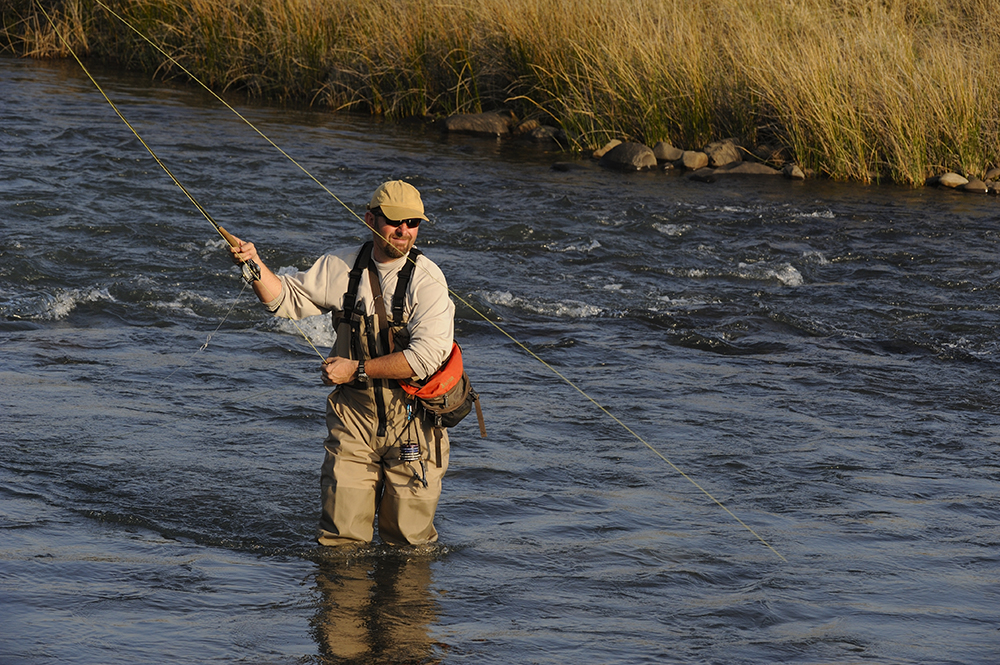 Sportsmen and women serve as the primary source for state wildlife management programs. Sportsmen and women serve as the primary source for state wildlife management programs.
|
In fact, most hunters cite their love of nature as a primary motivation for their hunting activities. Families commonly enjoy hunting, fishing, and other forms of outdoor recreation together, with fathers and mothers teaching sons and daughters about wildlife, living in nature, the workings of the environment, and the ethic of stewardship.
Sportsmen and women also serve as the primary funding source for state wildlife management programs. They finance conservation programs and projects by purchasing hunting and fishing licenses, tags and stamps, by buying hunting and fishing equipment, and by making private donations to conservation organizations. Since 1937, hunters have paid an excise tax on the purchase of hunting and fishing equipment, and the money collected goes to the states for conservation efforts based on a distribution formula. In 1950, Congress added the Dingell-Johnson Act to place a similar excise tax on fishing equipment. In 2011, hunters generated more than $1.1 billion for state conservation efforts, and in 2010, anglers generated more than $1 billion. States spend such funds on projects like wildlife population surveys, scientific data gathering, land set-asides, habitat restoration, and public education. And that’s not all.
Jay Norwood (Ding) Darling had a leading role in ensuring passage of the Federal Aid in Wildlife Restoration Act of 1937, also known as the Pittman-Robertson Act, which provides money to states for the purchase of game habitat and to help fund wildlife research through a tax on sporting firearms and ammunition.
Hunters and anglers have an enormous impact on the economy. In 2011, hunters spent $38 billion on hunting-related expenses, supporting 680,000 jobs, while in 2010, anglers spent $35 billion and supported 828,000 jobs.
General and species-specific conservation organizations also donate billions of dollars and thousands of hours each year to ensure stable populations of everything from ducks , pheasants and wild turkeys to elk and non-endangered big game. Each year, members of these groups donate hundreds of thousands of pounds of wild game to food kitchens and other programs to feed needy families. Many such groups also purchase land to provide species habitat. For example, Ducks Unlimited has conserved more than 13 million acres of waterfowl habitat since 1937, and the National Wild Turkey Federation over 17 million since 1973. To see a list of similarly-minded wildlife groups, go here.
Most conservation organizations have well-developed programs to promote ethical and responsible hunting and fishing behavior. Working with a dozen other conservation and sporting organizations, the Izaak Walton League of America created this “Hunter’s Pledge,” which calls sportsmen and women to a high standard of behavior.
“Responsible hunting provides unique challenges and rewards. However, the future of the sport depends on each hunter’s behavior and ethics. Therefore, as a hunter, I pledge to:
By following these principles of conduct each time I go afield, I will give my best to the sport, the public, and environment and myself. The responsibility to hunt ethically is mine; the future of hunting depends on me.”
Hunting and conservation groups also play an active role in advocating for science-based wildlife management policies and oppose laws and regulations based on appeals for outcomes that have no thorough fact-based foundation and are too frequently propelled by agenda driven fallacies and fund-raising campaigns.
Zoos and Conservation
Zoos and aquariums are important forces for wildlife conservation. Today’s zoos grew out of the zoological societies of the early 19th century—organizations formed by scientists to facilitate the scientific study of animals to ensure their survival. Although royal families often had collections of exotic animals in their private preserve, it wasn’t until the late 1820s that scientists became engaged in the collection of animals for scientific study. The Zoological Society of London was opened to scientists in 1829, and then to the public in 1847 to aid funding for upkeep and research.
The scientific focus of zoo and aquarium programs continues to this day. The American Zoo and Aquarium Association (AZA), the professional organization for these facilities in the U.S., has established scientific advisory groups to gather and share detailed knowledge of species' ecology, reproductive biology, genetics, behavior, nutrition and diseases. The organization also has formulated detailed animal care standards for virtually every species currently found in zoo facilities.
One of the most important functions of the AZA is its accreditation program. A commission of the association evaluates every zoo or aquarium to make sure it meets AZA's standards for animal management and care, including living environments, social groupings, health, and nutrition. Commissioners check to see that these institutions provide animals with enrichment that stimulates their natural behavior and provides variety in their daily routine.
The commission also evaluates the veterinary program, involvement in conservation and research, education programs, safety policies and procedures, security, physical facilities, guest services, and the quality of the institution's staff. And because a zoo or aquarium needs a strong foundation in order to continue to meet high standards, accreditation also evaluates each institution's finances, its governing authority, and its support organization.
Getting members of the public actively engaged in worldwide conservation is another important mission of accredited zoos and aquariums. In 2007, the AZA collaborated with the National Science Foundation, the Institute for Learning Innovation, and the Monterey Bay Aquarium to study whether their conservation education programs were producing results. The answer was a resounding “yes.” The study found that “visits to accredited zoos and aquariums prompt individuals to reconsider their role in environmental problems and conservation action, and to see themselves as part of the solution.”
Coming face-to-face with animals through interactive exhibits, interpretive tours and educational programs improves peoples’ understanding of the natural world, increases their scientific knowledge about wildlife, and engages them personally in the practice of responsible stewardship.
State Conservation Programs
In the U.S., every state has a conservation department to manage its wildlife and natural resources as directed by state law. With legislative authorization and funding, these experts study and analyze the state’s wildlife and natural resources, then develop and implement action plans to ensure their future health and sustainability.
In most states, conservation departments rely on revenues from hunting and fishing licenses for much of their funding. On average, 80% of a state agency’s funding comes from the federal excise tax revenues and license sales, compare to only about 2% from the federal fisc. By purchasing licenses, tags and stamps and hunting and angling equipment and by making private donations, sportsmen and women make it possible for these agencies to ensure that future generations have the same access to abundant fish and wildlife that we enjoy today.
Over the years, Federal excise taxes and state license revenue have helped bring back dozens of species, including ducks, wild turkeys and white-tailed deer. Fewer than 100,000 wild turkeys remained in the nation in 1900, and today there are 7 million.
It is worth noting that state fish and game agencies not only have the duty to manage “trust” species, i.e., species of fish and game for which harvest is legal, but also nongame or non-trust species. Agencies must find funding to manage the non-trust species, which can be difficult, since their hunting and angling constituencies are most interested in having populations of harvestable species. Nevertheless, managing for game species’ habitats can benefit many nongame species that depend on the same habitat. Furthermore, organizations such as Teaming with Wildlife are working hard to ensure that nongame species get some attention as well. They have recently started their Blue Ribbon Panel which will bring together top minds in the conservation community to discuss and plan to address the challenges facing management of nongame species as well as the future of conservation funding
As noted above, state conservation agencies, sporting organizations and other bodies participate in associations such as the Association of Fish and Wildlife Agencies (AFWA), which promotes sound management and conservation and enables wildlife professionals to speak with a unified voice on important fish and wildlife issues. State conservation agencies also belong to respective regional organizations such as NEAFWA, SEAFWA, MAFWA and WAFWA, which serve much the same purpose as AFWA.
Federal Conservation Programs
At the federal level, many agencies’ work involves fish and wildlife management. The Department of the Interior bears responsibility for the bulk of federal land and natural resource management, and is the largest player in this arena. Within the Interior Department, separate agencies are responsible for various policy areas. The Bureau of Land Management is responsible for administering U.S. public lands. The National Park Service administers national parklands. The Bureau of Reclamation runs many water management projects in the Western U.S.
The U.S. Fish & Wildlife Service (FWS), also under Interior, manages the nation’s fish, wildlife and plant conservation programs. It regulates endangered and threatened species through the Endangered Species Act; shares administration of the ESA with the National Marine Fisheries Service; establishes and enforces hunting and fishing regulations on some federal lands; regulates the movement of plants and animals across international borders; interacts with tribal governments to help conserve wildlife and habitat on tribal lands; manages federal lands such as wildlife refuges, and studies environmental factors that may affect fish and wildlife populations. The National Marine Fisheries Service under the Department of Commerce is the Fish & Wildlife Service’s counterpart for marine fisheries and has similar duties with respect to marine life.
The U.S. Department of Agriculture holds responsibility for conservation efforts on lands used primarily for agricultural purposes. The Natural Resources Conservation Service (NRCS) oversees programs to protect grazing lands, watersheds and wetlands. The Conservation Reserve Program (CRP) provides technical and financial assistance to farmers for the purpose of preventing erosion, improving water quality, reducing sedimentation in streams and lakes, and converting marginal farmlands to vegetative cover that provides abundant habitat for wildlife and waterfowl. The U.S. Forest Service is another sub-agency of the Agriculture Department; it encounters many fish and wildlife issues in its management of the national forests and other lands under its authority. The Endangered Species Act creates duties for all federal agencies to ensure they don’t harm threatened or endangered species on lands that they manage. The Council on Environmental Quality, which writes National Environmental Policy Act regulations to assure that federal agencies consider the environmental impacts of their proposed actions and offer reasonable alternatives to those actions, also has indirect impact on fish and wildlife management.
International Conservation Programs
One of the most important international conservation programs is CITES, the Convention on International Trade in Endangered Species. CITES (pronounced SIGH-tees) is actually an agreement between 175 nations to pass laws in their own countries to protect more than 30,000 species of flora (plants) and fauna (animals). The agreement specifically regulates the import and export of these species and controls trade in products derived from them, including items such as elephant tusks, animal skins and bones, and rhinoceros horns.
What are “Wildlife Corridors” and why are they important?
Another influential organization on the international stage is the International Union for the Conservation of Nature (IUCN). The IUCN supports scientific research, manages field projects all over the world and brings governments, non-government organizations (NGOs), United Nations agencies, companies and local communities together to develop and implement policy, laws and best practice. Its membership includes almost 1000 governments and non-governmental organizations, as well as more than 11,000 interested scientists from more than 160 nations.
The Global Conservation Program (GCP), a program funded by the U.S. Agency for International Development (USAID), also plays an important role in international conservation efforts. The GCP seeks to preserve biodiversity by working with local communities across the globe to create sustainable economies through managed use of the plant and animal species around them. USAID projects help people earn a living, govern their community, and manage their business more efficiently while protecting wildlife and the environment.
The Migratory Bird Treaty Act of 1918 was a great leap forward in wildlife protection. Initiated to end the lucrative trade in bird feathers, it was originally implemented by the US and Canada. Several other nations have since signed on to this pact that makes it illegal for anyone to take, possess, import, export, transport, sell, purchase, barter, or offer for sale, purchase, or barter, any migratory bird, or the parts, nests, or eggs of such a bird except under the terms of a valid permit issued pursuant to Federal regulations.
The migratory bird species protected by the Act are listed in 50 CFR 10.13. View the current rule and more information here.
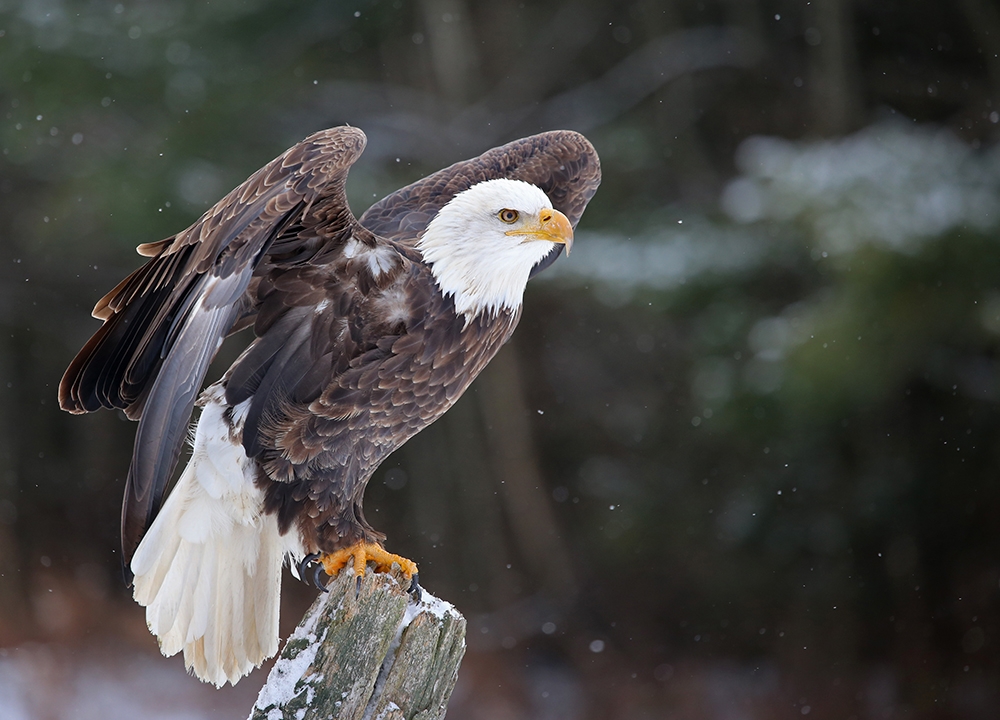 The Bald and Golden Eagle Protection Act prohibits killing the birds, taking or disturbing their nests or eggs, collecting their feathers, or disturbing their nesting activities. The Bald and Golden Eagle Protection Act prohibits killing the birds, taking or disturbing their nests or eggs, collecting their feathers, or disturbing their nesting activities.
|
The Bald and Golden Eagle Protection Act prohibits killing the birds, taking or disturbing their nests or eggs, collecting their feathers, or disturbing their nesting activities without a permit from the Department of Interior.
The Whaling Convention Act of 1949 (16 U.S.C. 916-9161; Act of August 9, 1950, as amended) authorizes the secretary of commerce to enforce the provision of the International Convention for the Regulation of Whaling and to issue regulations necessary for this purpose, appearing at 50 C.F.R. Parts 230 and 351. The secretary is authorized and directed to administer and enforce all provisions of the convention, this act, and regulations promulgated pursuant to this act. In conducting the duties prescribed under this act, the secretary of commerce cooperates with other agencies of the federal government, state governments, or other independent institutions.
Clearly, industrial, urban, suburban, and agricultural development have harmed the natural environment and its inhabitants, but the public agencies and private organizations noted above are working separately and in concert to protect wildlife and conserve and restore habitat throughout the country. However, they are not the only resources for information about the natural world. Some other groups seem to prefer policies that separate humans from the environment instead of acknowledging man as part of nature. To this end, these groups often campaign against hunting and fishing, fossil fuels, zoos and aquaria, and other types of man-and-animal interaction. Their strategies include
Sue and settle lawsuits give groups outside the government the power to short-circuit or circumvent the regulatory process by court decree. This power blocks public input, usurps the statutory role of federal agencies, causes federal agencies to focus on litigation, increases their workload, and denies other stakeholders an opportunity to make their case. For example, WildEarth Guardians and its fellow plaintiffs negotiated a sue and settle lawsuit with FWS that requires listing determinations for 251 species and a designation of threatened for the Lesser Prairie Chicken that cut agriculture, oil and gas drilling, wind farms and other interests out of the process and could potentially remove land from both farming and development and cost taxpayers money and jobs.
In addition to forcing their agenda on taxpayers and industry, the groups that bring these suits are eligible for reimbursement of their legal fees from a federal fund. The National Center for Policy Analysis report titled Environmental Regulation through Litigation details the sue and settle process and the regulatory burden imposed on business, industry, and private property rights.
Congress has twice considered bills to provide for transparency and accountability in the use of lawsuits to force agency actions. Both bills have failed. Last March, Oklahoma Attorney General Scott Pruitt filed suit against FWS. Oklahoma alleges in part that sue and settle lawsuits violate the Endangered Species Act mandate to use the best available science as a base for listing threatened and endangered species.
The Humane Society of the US has perfected the use of initiative petitions to change state laws governing hunting of particular species and housing for agricultural animals. The organization pays outsiders to gather signatures in a targeted state and spends millions of dollars to influence voters. Their most recent campaign to ban some bear-hunting methods in the State of Maine is mentioned above.
There seems to be a growing affinity between agency management and the outside groups that sue them, leading some to speculate that there is collusion to subvert the statutory process for dealing with potential changes in regulations. This speculation is fueled when agency personnel leave government employment and subsequently join a group that that used lawsuits to force agreement with its demands. For example, Jamie Rappaport Clark was director of US FWS during President Clinton’s second term and joined Defenders of Wildlife in 2003. She now serves as president and CEO of a group that has filed several sue and settle lawsuits against federal agencies. And reversing the path from public to private employment, Sarah Conant left HSUS to take a job with USDA. Conant had worked on several sue and settle suits against government agencies on behalf of HSUS.

 Discover Animals is a web-based educational resource offered by the NAIA
Discover Animals is a web-based educational resource offered by the NAIA